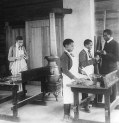|
|
 |
 |
|
Reading Guide |
| 4. |
Education
| - | Booker T. Washington, Up from Slavery, 1901, Ch. 8, "Teaching School in a Stable and a Hen House" |
| - | Frances Benjamin Johnston, photographs of students and teachers at Tuskegee Institute, Alabama, 1902 |
|
|
 |
In this excerpt from Up from Slavery we witness institution building in its most literal sense from clearing land, to renovating structures, to raising money. Here Washington makes his case for the practical, trades-based education he installed at the Tuskegee Institute. He must make that case not only to whites but, judging from the responses of some of his students, to the very rural blacks for whom he established Tuskegee. Although Washington's style is simple and unadorned, the chapter does contain some compelling images—the white stereotype of the educated Negro, the young man in greasy clothes reading a French grammar, the pretentious students, the heroic Miss Davidson, the self-declared preacher, and the "old coloured man" who was astonished that Washington was going to clean out a hen-house in daylight. How Washington deploys these images offers a rich opportunity for insightful discussion. 6 pages.
Frances Benjamin Johnston (1864-1952) provided visual images of life at Tuskegee. A pioneer among women photographers in the United States, she did much of her work for George Grantham Bain's news service, one of America's earliest news photo agencies. In 1902 Washington commissioned her to shoot photographs he could use in magazine articles and lectures promoting the Institute. The pictures offered here document classes at the Institute from lessons on Capt. John Smith and Jamestown (note the lesson on the board in the history class) to furniture making, mattress sewing, lab work, and printing. 3 pages (9 pages total in Education).
Discussion questions
- At what audiences does Washington aim Up from Slavery? What purpose does this chapter serve? How do the images he presents in it advance his purpose?
- What purposes do Johnston's photo serve?
- What values do they convey? How might a white audience interpret them in 1902? A black audience?
|
» Link |
 |
 |
Topic Framing Questions
| • |
What roles did institutions play in African American life at this time? |
| • |
In what ways did institutions shape and reflect African American identity?
|
|
|
 |
 |
|
 |
